
Wine Culture and Information since 2002 - Volume 22
 Wine Culture and Information since 2002 - Volume 22 |
|
Issue 52, May 2007 |
Contents |
|
|
One Hundred Thousand! |
|
One Hundred Thousand! For many this could sound not very important, but for us, who are working in this project since almost five years, it is a good result. Of course it could be better, however, we think it is a good result anyway. The last month of March, after months of waiting, we have finally seen our readers to grow until reaching one hundred thousand. After having waited for months, by reading the figures of the statistics, it seemed the average number of our readers would have stopped at 95,000, then reached 97,000, finally in the month of March the average number of DiWineTaste's readers has reached 100,000! This was one of our goals and for which we worked hard and that - finally - we have reached. This was not only because of us, of course. The merit is also of you all, dear readers, who every month download our magazine or read it on line, who use the services available in our site daily and send us your appreciation with the many letters we receive every day. We like the idea of sharing this important success with you all, because - undoubtedly - this is also the success of you all, of all DiWineTaste's readers. It is also the success of whom, in these years, has sent comments and criticisms - which we do not have always agreed on but we have always respected and listened to - and allowed us to improve DiWineTaste, to change and renew some aspects, to let our magazine meet the expectations of our readers. Our thanks also go to the many producers who in these years have granted us their trust and have sent their wines and distillates to us, therefore allowing us to talk about their job and on what they do believe and pass it to the time by enclosing it in a bottle of glass. In this sense, we like to remember the fundamental principle on which we have always based our editorial job since the beginning of this adventure. DiWineTaste is - and has always been - an independent publication from everything and from everyone, never depending on whoever is ready to accept certain compromises, as well as not agreeable ways, only because they want to have the sad satisfaction of seeming what they are not. The review of wines and producers in DiWineTaste have always been done with the same criteria: the only thing we asked producers is to ship their wines to our office and nothing more. This can be witnessed by the over 450 producers who trusted us and believed in our editorial project. We believe this is the correct and honest way to review wine and make information, also, and in particular, in respect of our readers - and without them we would not be here today to comment this result - last but not the least, also for the respect of whoever makes wines or distillates and believes in his or her job. Also for this reason we never believed it could be right to be in a pulpit and to speak “absolute” verdicts, neither about wines nor distillates, neither about producers, including the opinions and job of our colleagues who - like us - write about wine. In our comments we just limit ourselves to simply tell a wine or a distillate the way we met and saw it, uniquely allowing us the expression of a score - our diamonds and stars - in order to give a “measure” of our appreciation. We do not think it would be right to tell which wines should be bought and what wines should be avoided. Besides considering this behavior to be correct, we are aware of the fact what we do not like may be liked by others, and vice versa. The relationship each one of us has with pleasure - including the pleasure of wine and distillates - is so personal that would be presumptuous to define it or to suggest it, even worse, to impose it. And we have no intention to make this editorial look like a praise to our job in the useless intent of being considered better than others. We are absolutely aware we are not, we are aware of the fact what we did so far can be improved and we have so many things to learn. However, despite there is so much things to improve, for the moment we are happy to celebrate all of our one hundred thousand readers: a result which is also the result of the appreciation of all of you readers who read our magazine every month. It has been a long way to get here, a sequence of changes and the introduction of new services. The first substantial change was in September 2003 - after one year from the beginning of our project - with the publication of the new site. The first “interactive” service offered to our readers was published in January 2003: DiWineTaste Wine Guide. Of the many other services and changes introduced during the period of our activity, we would like to mention the last one - DiWineTaste Mobile - which allows the free use of Wine Guide, Aquavitae and Services Directory from a mobile phone, a very appreciated service by our readers and which suggests good places where enjoying wine as well as getting information about wines and distillates. Also the polls are very appreciated by our readers and which receive hundreds of votes every day. A tool to let us know our readers better as well as to understand the opinion of consumers. Not to mention EnoGames, they too being very appreciated by our readers. In about five years we tried to spread the culture of wine, of wise drinking, to offer our modest contribution to the vast world of wine, to the pleasure of tasting and moderation. In about five years we have poured in our glasses about 2,200 wines of over 430 producers, all of them commented in our Wine Guide, one of the most used and appreciated interactive services by our readers. We like the idea of celebrating this important result with our readers, and although we would have liked to celebrate it differently, the least we can do is to say thanks to everyone from the deep of our heart, to the ones who read our magazine since 2002, to all the ones who joined us in the course of the years. Thanks to all of you, dear readers: if DiWineTaste has reached one hundred thousand readers, if it reached today this important goal and if it continues to exist, it certainly is because of your fundamental contribution and of your appreciation, of your comments as well as of your criticisms, always useful and always accepted. Thanks to you all!
|
||||
MailBox |
|
In this column are published our reader's mail. If you have any comment or any
question or just want to express your opinion about wine, send your letters to
our editorial or fill in
the form available at
our site.
|
| First of all, congratulations for your site, both for the contents and the way they are organized. I would like to ask a couple of questions about the tasting of wine at the restaurant. As the purpose is to make sure the wine has no faults, why is the glass swirled therefore favoring the oxygenation of wine? Is this procedure also done for sparkling wines and champagne? |
| Matteo Brandi -- Grosseto (Italy) |
| Thanks for your compliments: we wish DiWineTaste will always be of your satisfaction and of your interest. As for your two questions, the tasting of wine at the restaurant is a procedure which is done for every wine, including sparkling wines and champagne. Generally speaking, it is the sommelier - or however the person in charge of serving wine in a restaurant - to make sure the wine ordered by the client is in good conditions and has no faults. For this reason, the sommelier tastes the wine before offering it to the client, and in case he or she thinks the wine is in good conditions, offers a glass to the client for tasting. The first phase is usually omitted and, after having uncorked the bottle, a small quantity is poured in the client's glass who will taste it and decides about its good condition. As you rightly observed, the glass is being swirled in order to favor the oxygenation of the wine. Indeed, this operation should be done after having evaluated “opening” aromas - that is the aromas made of light molecules requiring a small quantity of oxygen in order to volatilize - an operation which is done by holding the glass still and without swirling. After having checked the absence of faults in this first phase, the glass is then swirled and a second smell is done: this operation favors the volatilization of “heavy” molecules. If also in this phase are not found faults, a small sip of wine is finally tasted, therefore ending the evaluation. Finally, it should be considered temperature: faults are easily recognized at higher temperatures. |
| I own a small vineyard from which I harvest the grapes for the production of a home made wine. As the quantity is of about some tens of liters, I ferment the must in demijohns which are also used for the aging. Is the use of demijohns negative for the fermentation and aging of wine? |
| Marco Menicucci -- Jesi, Ancona (Italy) |
| The use of demijohns in home wine making has no disadvantages, provided all the necessary precautions for the biological stability of wine are being followed. In presence of small quantities - like in your case - the use of casks or tanks has some unpractical inconveniences, as the small quantity would not allow the complete filling, therefore leaving the wine dangerously exposed to the negative effects of air. It is therefore better to use a demijohn, having a volume such to allow the complete filling during aging. During fermentation, it can be used the special demijohn “air-lock caps”, available in specialized wine making shops. During aging it will be paid attention to fill the demijohn up to some centimeters below the opening, by isolating the wine exposed to the air with a layer of vaseline oil, or with special paraffin discs containing allyl isothiocyanate - that is the essence of mustard - which will make the space between wine and cap aseptic. It should be remembered these discs must be periodically replaced. Finally the place where demijohns are being kept must be dark, with the right temperature and moisture, and which should be kept as much constant as possible. |
Eiswein - Ice WineA wine coming from the cold, a sweet nectar produced in wintertime by waiting the cold to literally freeze grape berries in the vine |
|
Sweet wines have always fascinated the sense and the fantasy of wine lovers of all times. Most of the times expensive and rare, their presence was practically constant in the tables of noble and wealthy people, also as a sign of richness. Rich, thick, sweet, complex in their aromas and in flavors, sweet wines offer an unique sensorial experience. However, it does not take sweetness only to make a great sweet wine as not all the methods used to add or keep sugar in a wine give the same results, neither according to an organoleptic point of view, nor according to quality. There are in fact many ways to make a sweet wine, of them the least “noble” one certainly consists in adding sugar at the end of production. What fascinates about sweet wines is their organoleptic complexity, that extraordinary concentrate of aromas and flavors going far beyond sweetness, a result which is mainly obtained by the concentration of substances contained in grape berries.
Also ripeness - or better to say, the overripeness - of the grape plays an important role in the final result, as this natural process gives the increasing of sugar and the exaltation of “ripe” aromas, while diminishing acidity. Despite this is an excellent method for getting the best sweetness from grapes, indeed, also acidity plays a primary role, essential for the harmony and balance of the wine. One of the most ancient methods for the production of sweet wines consists in harvesting ripe grapes and to allow them to dry on the air - hanged in frames or left on mats - in order to favor the progressive loss of water with the result of concentrating juice. Alternatively, the grape is allowed to directly dry on the vine which will be then harvested as soon as it reaches the right level of concentration and withering. Another method - which can be used in the areas having the right climate and environmental conditions - makes use of a factor which could seem detrimental for the health of grapes and of wine, however, provided the right conditions, it gives grape juice with extremely refined organoleptic qualities: mold. It is a particular mold - Botrytis Cinerea - which in favorable conditions gives divine nectars and in case it excessively develops, inexorably condemn the whole harvest. Botrytis Cinerea, also known as noble rot when it does excessively develop by literally rotting the grape, is a serious problem for every vintner, welcomed only in grapes destined to the production of some sweet wines, prevented in all other cases. Noble rot, by penetrating the skin of the berry in search of nutrition, favors the loss of water while concentrating the juice, also giving the juice its organoleptic qualities. There is also another method to concentrate grape juice: freezing the water inside the berries followed by an immediate crushing. This system can be obtained in two distinct ways, one of them being absolutely natural and obtained in particularly cold areas, the other by artificially freezing grape berries. This latter method is defined as cryoextraction and it is used, in order to concentrate the must, also in the production of other wines. Where conditions allow it, this method is naturally realized thanks to low winter temperatures, by harvesting frozen grape berries directly from the vine. This is how the precious and excellent Eiswein are produced, as they are called in Germany and in Austria, and ice wine - or Icewine - name with which they are known in Canada. Another characteristic of Eiswein is the absence of Botrytis Cinerea, therefore the acidity in these wines will be pretty high, however keeping a perfect and extraordinary balance with all the other organoleptic qualities. The origins of Eiswein are not very clear: the only reliable information is they have been “invented” in Germany. Some believes the production method for these wines was accidentally “discovered” in 1794 in Franconia, the famous region located in the central-southern part of Germany. It seems in 1794, in the city of Würzburg occurred an unexpected frost which caused the freezing of grapes. Vintners of the area, in order to save the harvest, decided to crush those grapes and they got an extremely concentrated must which produced that wine today renowned as Eiswein. This is not the only hypothesis about the “discovery” of Eiswein. According to other hypotheses, it seems the first Eiswein of the history was produced in Dromersheim - in Rheinhessen - with the grapes of vintage 1829, a particularly cold year. It seems in the winter of 1829-1830, vintners of that area, in order to save the harvest damaged by the frost and to use them to feed the cattle, they noticed the juice was exceptionally sweet. They decided to crush those “frozen” grapes and with the few juice they obtained produced a sweet and exquisite wine: Eiswein. It will be only at the end of the 1960s this technique will be improved thanks to the work of Dr. Hans Georg Ambrosi, the man considered the “father of Eiswein”. Hans Georg Ambrosi began his experiments about Eiswein in 1955, when he was in South Africa to study. When he went back to Germany, he continued his studies about this wine and established a winery in Rheingau, therefore starting the production of Eiswein. Other German producers followed his example and Eiswein become a typical product of Germany. Despite Germany is considered the homeland of Eiswein, climate conditions do not allow its production every year. Where the production of Eiswein is ensured every year is Canada, here known as Ice Wine, which became in a short time the main producer in the world for this type of wine. Canada officially enters the history of this wine in 1973, the year in which was produced the first Ice Wine of the country by Walter Hainle, a German emigrated in Canada in 1970. Thanks to the constant climate winter conditions, as opposed to Germany, Canada produces Ice Wine every year, a condition which allowed experimentation and the improvement of the production technique. The worldwide success of Ice Wine will be consolidated in 1990s thanks to the productions of Canada, Germany and Austria, officially entering the Olympus of the greatest dessert wines of the world. Eiswein - Ice Wine are in fact considered among the most looked for and appreciated dessert wines of the world, and most of the times the production is not enough to satisfy all the market needs. The main production area for Ice Wine is the Niagara peninsula, in the Ontario, where the Ice Wine is mainly produced with Vidal, a hybrid grape from France.
|
||||||||||||
|
The production of Eiswein - or Ice Wine - is a laborious process requiring the presence of specific climate conditions and particular procedures of wine making. First of all, the cold. Grape clusters are left on the vine during wintertime and the repeated frosts favor the concentration of sugar, acid and aromatic substances, with the result of exalting the organoleptic complexity of juice. The long waiting for the arrive of the cold however represents a pretty serious condition of risk, as during this period the grape could be damaged by many factors. In fact, in case the frost does not arrive at the right time, that is without being too late, grapes could be an easy victim of mold, therefore causing the loss of the whole harvest. However, in case the frost is too rigid, grape berries would excessively “freeze”, therefore not allowing the extraction of the concentrated juice. Grapes are harvested during wintertime, when the temperature is usually lower than -8° C (18° F) and the water inside of berries is frozen in ice crystals. The work of harvesting must be done in the shortest possible time, as the grapes must be crushed before they thaw, generally during night or in the first hours of the morning, that is when temperature reaches the lowest values of the day. Also vinification rooms must have a very low temperature in order to avoid the thawing of grapes before they are crushed. As the water contained in berries is frozen in ice crystals, it will not be extracted and the few juice extracted from the crushing is an extremely concentrated must, rich of sugar and acid. The concentration of sugar in Eiswein - Ice Wine is generally from 180 and 320 grams per liter, a quantity such to make fermentation extremely slow. The fermentation of the must for the production of Eiswein can also take some months and the vinification is made both in inert containers - such as steel tanks - as well as oak casks or barriques. Eiswein are generally produced with white berried grapes, however there are also examples of wines produced with red berried grapes. Among the many varieties used for the production of Eiswein - Ice Wine, Riesling certainly is the most important one, followed by Vidal, typical in Canadian productions. Among the other white berried grapes used for the production of these wines are mentioned: Chardonnay, Chenin Blanc, Ehrenfelser - a crossing between Riesling and Sylvaner - Gewürztraminer, Kerner, Pinot Blanc and Seyval Blanc, a hybrid obtained from two Seibel grape hybrids. Among red berried grapes, the most typical one is Cabernet Franc, however are also used Cabernet Sauvignon, Merlot, Pinot Noir and, marginally, Syrah.
|
|
The production technique of Eiswein - Ice Wine is used in many countries of the world, however the main representatives of this wine are Canada, Germany and Austria. The essential condition for the production of these excellent wines is represented by a winter with very low temperatures, in order to cause the freezing of the water contained inside grape berries. Eiswein - Ice Wine is also produced, although in limited quantities, in Australia, Croatia, France - here known as Vin de Glace - Italy, New Zealand, Czech Republic, Slovakia, Slovenia, United States of America and Hungary. The production of Eiswein - Ice Wine is regulated by specific laws in each of these countries and in some cases production disciplinary is very strict in order to ensure the best possible quality. One of the most controversial techniques in the production of these wines is the so called cryoextraction, which allow the artificial freezing of grape berries, therefore allowing the production also in areas or years with not particularly cold winters. For example, cryoextraction is expressly forbidden in Canada, Germany and Austria, whereas in other countries this technique is sometimes permitted. In Canada Ice Wines are produced in British Columbia and Ontario, area from which comes the highest quantity produced in the world, in particular in the Niagara Peninsula. In Canada, the production of Ice Wine is regulated by a specific disciplinary instituted by the Vintners Quality Alliance, shortened as VQA. In Germany Eiswein is represented by a specific category of the quality system QmP (Qualitätswein mit Prädikat, Quality Wines with Predicate). Also the production of Eiswein in Austria is regulated by the quality system in force in this country. Austrian Eiswein is in fact included in the highest level of the system - Prädikatswein - for which it is provided a specific category.
|
Comparing BaroloOne of the most famous wines of Italian enology, defined by many as “king of wines, wine of kings”, Barolo is the magnificent Langhe's wine produced with Nebbiolo grape |
|
In the vast Italian wine making scene, Barolo is among the brightest stars, son of one of the greatest grapes of the rich ampelographic heritage of Italy: Nebbiolo. Barolo is not the only “son” of Nebbiolo, indeed, it certainly is the wine which was the first one to make this prestigious grape from Piedmont renowned all over the world. Also thanks to the enological culture of Piedmont - a pretty rare case in Italy - Barolo is one of the few Italian wines to be classified according to specific cru and in the labels is mentioned, most of the cases, the name of the vineyard or commune as well. The identification of Barolo's crus begins thanks to the important contribution of Renato Ratti, the famous wine maker who, in the 1970s, does scrupulous researches on the territory, on vineyards and on the many communes: a meticulous and fundamental job which will allow the creation of the so called “Map of Barolo”, in which are defined the production areas of this glorious wine. Nebbiolo - from which it is produced Barolo - is a pretty demanding grape, both according to a viticultural point of view, as well as according to environment. Nebbiolo tends to ripe later than other varieties, usually harvested in autumn, when vineyards are covered by fog (nebbia in Italian), a phenomenon from which takes its name. Nebbiolo is a difficult grape also in the wines it makes, with a personality on their own which is hardly found in other wines. With its richness in polyphenols and tannins - among the richest grapes known - wines produced with Nebbiolo are characterized by a robust body as well as for their elegance: two qualities which make usually define these wines as an iron fist in a velvety glove. Another typical quality of Nebbiolo is its high acidity which contributes to the “harshness” of its wines however giving a truly personal crispness. For these reasons, wines produced with Nebbiolo need a proper quantity of alcohol and a proper period of aging in wood in order to obtain a gustatory balance.
|
|
Barolo, besides its famous and particular grape, is also subject of debates both from producers and wine lovers. The reason of these debates is not determined by Nebbiolo and by its characteristics, indeed by the method with which it is being produced Barolo. Not the whole production method, but just one “detail” which could be defined as the wood factor. Barolo is traditionally aged in large casks, whereas in recent times, some producers have introduced the “modern” barrique, marking a strong division. Traditionalists prefer the use of large casks, whereas modernists prefer barrique: definitions which are used both for producers and wine lovers. Despite in recent times the “debate” is getting less and less strong, to many this is still a fundamental point, however the evidence of facts has proven with time both methods make excellent Barolos, undoubtedly different one from another - of course - however both extraordinary, so extraordinary like the Barolo can be.
In our comparative tasting about Barolo we will try to understand the differences which are the cause of this “debate”: cask and barrique. It would have certainly been interesting - as well as didactic - to understand the differences among the many crus, however, because of the differences found in the wines produced in the many, this would certainly take more than three wines. The first wine of the tasting is Conterno Fantino's Barolo Sorì Ginestra, aged in barrique for 24 months. The second wine of our comparative tasting is Massolino's Barolo Riserva Vigna Rionda, aged in large casks for 36 months. The last wine represents an “in between”, as it is produced by using both techniques: Abbona Marziano's Barolo Pressenda, aged for 12 months in barrique and 18 months in large cask. Undoubtedly, three magnificent Barolos, however each different one from another. The three wines will be served at a temperature of 18° C (64° F) and will be served - as usual - in three ISO tasting glasses.
|
||||||||
|
Despite Nebbiolo is a grape rich in polyphenols, it is however poor in coloring substances, therefore in its wines will rarely be seen deep colors and also transparency will be pretty high when compared to other red wines. This characteristic however depends on the quality of grapes and wine making, something which can be witnessed by many wines produced with Nebbiolo in which are observed intense colors and low transparency. Of course, also in the appearance of Barolo we will find these qualities. During its youth, Barolo shows intense and brilliant ruby red colors and the nuance will tend to garnet red. With time, Barolo will show, even after few years, garnet red colors and, sometimes, brick red, a color which is generally observed in nuances even in the first phases of aging. In general terms, the transparency of Barolo is pretty high, however in some cases it can also be low and with time it will however tend to increase because of the sedimentation of coloring substances. The first wine of which we will examine appearance is Massolino's Barolo Riserva Vigna Rionda. By holding the glass tilted over a white surface - such as a tablecloth or a sheet of paper - we will observe color and transparency. The color of the wine, observed at the base of the glass, is brilliant ruby red with a pretty evident transparency. By observing the liquid mass to the edge of the glass, we will examine the nuance of the wine which will show a brick red color. Let's now pass to the evaluation of the second wine: Abbona Marziano's Barolo Pressenda. The color of this Barolo is pretty similar to the previous wine, with a brilliant ruby red color, an evident transparency and brick red nuances. Let's now pass to the third wine - Conterno Fantino's Barolo Sorì Ginestra - the only of the three wines to be completely aged in barrique. The color of this Barolo is brilliant ruby red and, as opposed to the previous wines, it shows a lower transparency, and differences will be observed in nuances as well, in this case garnet red.
|
|
Olfactory qualities of Barolo are elegant and powerful at the same time. With time, this extraordinary wine does not disappoint the taster with its complex and rich aromas. A world full of fruits and flowers that, with time, get enriched and turn into incredible aromas continuously inviting to smell the glass. Among the most typical fruit aromas in Barolo are mentioned cherry, plum and raspberry, whereas as for flower aromas, violet and rose. Barolo, according to production disciplinary, before being commercialized, must age for at least three years - five for the reserve style - of which at least two in oak or chestnut casks. The choice of type and volume of cask directly influences Barolo's olfactory qualities: a Barolo aged in cask develops aromas different from the one aged in barrique. Among the most typical tertiary aromas developing in a Barolo after years of aging are mentioned tobacco, licorice, chocolate, leather, tar and cocoa as well as truffle and mushrooms. The world of aromatic herbs is represented by thyme and mint, whereas the most frequent balsamic aroma is menthol. The first wine we will examine is Massolino's Barolo Riserva Vigna Rionda. By holding the glass in vertical position and without swirling, we will begin by evaluating opening aromas, that is the aromas which can easily volatilize with a small quantity of oxygen. From the glass will be perceived aromas of cherry and violet, the two most typical olfactory characteristics of Nebbiolo and Barolo. We will now proceed by swirling the glass in order to allow the oxygenation of wine and favoring the volatilization of “heavier” aromatic substances, that is substances requiring a higher quantity of oxygen in order to be perceived. After the second smell, it will be possible to perceive from the glass aromas of plum and raspberry - also in this case characteristic of Nebbiolo and Barolo - as well as clean and intense aromas of rose and blackberry, followed by more complex aromas of vanilla, tobacco, licorice, cinnamon, cocoa and pink pepper. It should also be noticed the pleasing hint of menthol. Let's now pass to the second wine of our comparative tasting: Abbona Marziano's Barolo Pressenda. Opening aromas are characterized by cherry, raspberry and violet, whereas the second smell - after having swirled the glass - will reveal aromas of plum, rose, strawberry and cyclamen followed by aromas of vanilla, tobacco, licorice, cinnamon, cocoa, cigar box, mace and the balsamic hint of menthol. Whereas the previous wine was completely aged in cask, in this second wine the aging was done both in cask and in barrique: it should be compared the difference and the intensity of tertiary aromas. Let's now pass to the third wine of the tasting - Conterno Fantino's Barolo Sorì Ginestra - the only one of the three to be aged in barrique. Opening aromas are characterized by cherry, plum, blackberry and violet followed by aromas of rose, vanilla, licorice, tobacco, cocoa, mace, menthol and thyme. It should be compared the aromatic impact of this wine with the previous ones: differences among aging in cask and in barrique are evident, however very elegant in both cases.
|
||||
|
An iron fist in a velvety glove: this is the main sensation perceived in the mouth when a wine produced with Nebbiolo, in particular Barolo, is tasted. Whoever expects from a wine roundness and smoothness, will probably be disappointed by Barolo. Robust structure scratched by a pleasing crispness is opposed to the roundness of alcohol and the smoothness of the aging time gives Barolo: a wine which cannot certainly be defined as “easy”. Nevertheless, Barolo's elegance and class, in its balance and personality - last but not the least, its body - are always a good surprise for the palate of tasters. It is not by chance Barolo is one of the many wines defined as “wine of the king, king of wines”, thanks to its personality, elegance and structure, it is an excellent companion of rich and refined dishes. The evident crispness and astringency in Barolo require, in order to be balanced, a proper quantity of alcohol and the average volume is typically of 13.5%. We will begin the gustatory analysis from Massolino's Barolo Riserva Vigna Rionda. The attack of this Barolo confirms our expectations: full body and crispness with the pseudo caloric sensation of alcohol. A robust structure, however characterized by a pleasing roundness - given by the aging in cask and alcohol - very elegant and very correspondent to the nose. Let's now pass to the second wine of our comparative tasting: Abbona Marziano's Barolo Pressenda. The attack of this Barolo is characterized, once again, by a robust structure and pleasing crispness, however roundness will be more evident than the previous wine. The attack of the third wine - Conterno Fantino's Barolo Sorì Ginestra - is not different from the previous wines: full body and pleasing crispness well balanced by alcohol and roundness of the aging in cask, in this case 24 months in barrique. Once again, let's taste all the three the wines in order to compare gustatory differences, in particular roundness in function of the type of cask used.
|
|
Barolo is a magnificent wine - and this is not anything new - and the three exemplars used in our comparative tasting fully confirm this. The finish of Massolino's Barolo Riserva Vigna Rionda is persistent with long and clean flavors of cherry, plum and raspberry: a finish which can be defined typical for Barolo. Also the finish of the second wine - Abbona Marziano's Barolo Pressenda - is very persistent with long flavors of cherry, raspberry and plum. The finish of Conterno Fantino's Barolo Sorì Ginestra is very persistent, just like the previous wines, however with more “robust” flavors of cherry and plum. It should be noticed how in all the three Barolos of our comparative tasting the perception of structure is present in the final phases as well, in particular, it should be noticed the finish according to the type of cask used for the aging. Barolo, despite cask and barrique give different organoleptic qualities, is however a wine of great elegance and class: this could certainly be enough to bring “peace” among traditionalists and modernists, hopefully ideally meeting in the magnificence of a good glass of Barolo.
|
Wines of the Month |
|
|
|
Score legend Prices are to be considered as indicative. Prices may vary according to the country or the shop where wines are bought |

|
|
Sant'Antimo Cabernet Sauvignon 2004 |
|
| Molino di Sant'Antimo (Tuscany, Italy) | |
| Grapes: Cabernet Sauvignon | |
| Price: € 8.00 | Score: |
| This wine shows a brilliant ruby red color and nuances of ruby red, moderate transparency. The nose denotes intense, clean, pleasing and refined aromas that start with hints of plum, black currant and black cherry followed by aromas of blueberry, violet, vanilla, bell pepper, cinnamon and menthol. The mouth has good correspondence to the nose, a tannic attack and pleasing roundness, however balanced by alcohol, good body, intense flavors. The finish is persistent with flavors of plum, black cherry and black currant. Sant'Antimo Cabernet Sauvignon ages for 2 months in barrique. | |
| Food Match: Broiled meat and barbecue, Roasted meat, Stewed meat with mushrooms | |
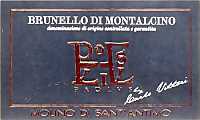
|
|
Brunello di Montalcino 2001 |
|
| Molino di Sant'Antimo (Tuscany, Italy) | |
| Grapes: Sangiovese Grosso | |
| Price: € 28.00 | Score: |
| This Brunello di Montalcino shows a brilliant ruby red color and nuances of garnet red, moderate transparency. The nose reveals intense, clean, pleasing and refined aromas that start with hints of black cherry and plum followed by aromas of violet, vanilla, raspberry, tobacco, licorice, chocolate, cinnamon, mace and menthol. The mouth has good correspondence to the nose, a tannic attack and however balanced by alcohol, full body, intense flavors. The finish is persistent with flavors of black cherry and plum. This Brunello di Montalcino ages for 3 months in cask followed by 6 months of aging in bottle. | |
| Food Match: Game, Roasted meat, Braised and stewed meat, Hard cheese | |
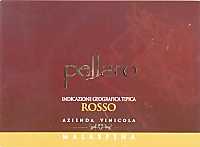
|
|
Pellaro 2003 |
|
| Malaspina (Calabria, Italy) | |
| Grapes: Nerello Cappuccio (50%), Nocera (30%), Cabernet Sauvignon (20%) | |
| Price: € 11.00 | Score: |
| Pellaro shows a brilliant ruby red color and nuances of garnet red, moderate transparency. The nose reveals intense, clean, pleasing and refined aromas which start with hints of plum, blackberry and black cherry followed by aromas of violet, cinchona, vanilla and carob. The mouth has good correspondence to the nose, a tannic attack and however balanced by alcohol, good body, intense flavors. The finish is persistent with flavors of plum and blackberry. Pellaro ages for 10 months in barrique. | |
| Food Match: Broiled meat and barbecue, Roasted meat, Stewed meat | |

|
|
Patros Pietro 2003 |
|
| Malaspina (Calabria, Italy) | |
| Grapes: Magliocco Canino (80%), Cabernet Sauvignon (20%) | |
| Price: € 20.00 | Score: |
| Patros Pietro shows a brilliant ruby red color and nuances of garnet red, moderate transparency. The nose reveals intense, clean, pleasing and refined aromas that start with hints of black cherry, plum and raspberry followed by aromas of violet, cyclamen, strawberry, vanilla, carob and menthol. The mouth has good correspondence to the nose, a tannic attack and pleasing roundness, however balanced by alcohol, good body, intense flavors. The finish is persistent with flavors of black cherry and plum. Patros Pietro ages for 6 months in barrique. | |
| Food Match: Roasted meat, Braised and stewed meat with mushrooms | |
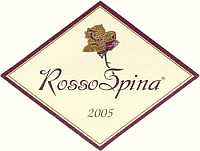
|
|
Rosso Spina 2005 |
|
| Cantina La Spina (Umbria, Italy) | |
| Grapes: Montepulciano (90%), Merlot (5%), Gamay (5%) | |
| Price: € 14.00 | Score: |
| Rosso Spina shows an intense ruby red color and nuances of ruby red, little transparency. The nose denotes intense, clean, pleasing and refined aromas that start with hints of black cherry, plum and blueberry followed by aromas of violet, vanilla, rose, raspberry, carob and cinnamon. The mouth has good correspondence to the nose, a tannic attack and however balanced by alcohol, good body, intense flavors. The finish is persistent with flavors of black cherry, plum and raspberry. Rosso Spina ages for 12 months in barrique. | |
| Food Match: Roasted meat, Broiled meat and barbecue, Stewed meat, Hard cheese | |
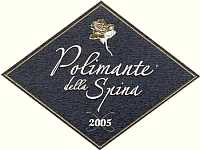
|
|
Polimante della Spina 2005 |
|
| Cantina La Spina (Umbria, Italy) | |
| Grapes: Merlot (70%), Gamay (30%) | |
| Price: € 15.00 | Score: |
| This wine shows an intense ruby red color and nuances of ruby red, little transparency. The nose reveals intense, clean, pleasing and refined aromas that start with hints of black currant, black cherry and plum followed by aromas of blueberry, vanilla, bell pepper, pink pepper, tobacco, chocolate and eucalyptus. The mouth has good correspondence to the nose, a tannic attack and however balanced by alcohol, full body, intense flavors, pleasing roundness. The finish is persistent with flavors of black cherry, black currant and plum. Polimante della Spina ages for 12 months in barrique. | |
| Food Match: Game, Braised and stewed meat, Roasted meat, Hard cheese | |
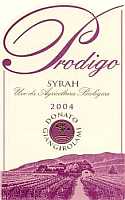
|
|
Prodigo 2004 |
|
| Donato Giangirolami (Latium, Italy) | |
| Grapes: Syrah | |
| Price: € 4.00 | Score: |
| The wine shows an intense ruby red color and nuances of ruby red, little transparency. The nose denotes intense, clean and pleasing aromas which start with hints of plum, black cherry and blueberry followed by aromas of vanilla, violet and carob. The mouth has good correspondence to the nose, a slightly tannic attack, however balanced by alcohol, good body, intense flavors. The finish is persistent with flavors of plum and black cherry. Prodigo ages for 6 months in barrique followed by 4-6 months of aging in bottle. | |
| Food Match: Stewed meat, Roasted meat, Broiled meat and barbecue | |
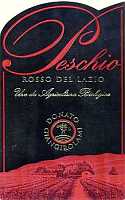
|
|
Peschio 2005 |
|
| Donato Giangirolami (Latium, Italy) | |
| Grapes: Cabernet Sauvignon (50%), Merlot (25%), Syrah (25%) | |
| Price: € 4.35 | Score: |
| Peschio shows an intense ruby red color and nuances of ruby red, little transparency. The nose reveals intense, clean and pleasing aromas which start with hints of black cherry and plum followed by aromas of blueberry, black currant, violet, vanilla and chocolate. The mouth has good correspondence to the nose, a tannic attack and however balanced by alcohol, good body, intense flavors. The finish is persistent with flavors of black cherry and plum. Peschio ages for 7-8 months in barrique followed by 7-8 months in bottle. | |
| Food Match: Broiled meat and barbecue, Roasted meat, Stewed meat | |
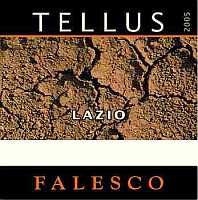
|
|
Tellus 2005 |
|
| Falesco (Umbria, Italy) | |
| Grapes: Merlot (50%), Syrah (50%) | |
| Price: € 6.48 | Score: |
| The wine shows an intense ruby red color and nuances of ruby red, little transparency. The nose denotes intense, clean, pleasing and refined aromas that start with hints of plum, black cherry and black currant followed by aromas of blueberry, raspberry, violet and carob. The mouth has good correspondence to the nose, a tannic attack and however balanced by alcohol, good body, intense flavors. The finish is persistent with flavors of black cherry and blueberry. The Syrah used for the production of Tellus ages for one month in barrique whereas the Merlot ages in steel tanks. | |
| Food Match: Broiled meat and barbecue, Stewed meat | |
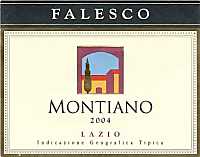
|
|
Montiano 2004 |
|
| Falesco (Umbria, Italy) | |
| Grapes: Merlot | |
| Price: € 25.80 | Score: |
| Montiano shows a deep ruby red color and nuances of ruby red, little transparency. The nose reveals intense, clean, pleasing, refined and elegant aromas which start with hints of black cherry, black currant and plum followed by aromas of violet, vanilla, blueberry, blackberry, tobacco, licorice, mace, eucalyptus and chocolate. The mouth has good correspondence to the nose, a tannic attack and pleasing roundness, however balanced by alcohol, full body, intense flavors. The finish is persistent with flavors of black cherry, black currant and plum. Montiano ages for 12 months in barrique. | |
| Food Match: Game, Roasted meat, Braised and stewed meat, Hard cheese | |
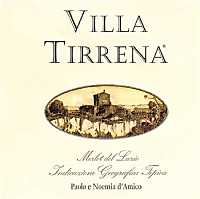
|
|
Villa Tirrena 2004 |
|
| Paolo e Noemi d'Amico (Latium, Italy) | |
| Grapes: Merlot | |
| Price: € 6.90 | Score: |
| Villa Tirrena shows a brilliant ruby red color and nuances of ruby red, moderate transparency. The nose denotes intense, clean and pleasing aromas that start with hints of black cherry, black currant and plum followed by aromas of vanilla, violet, tobacco and carob. The mouth has good correspondence to the nose, a slightly tannic attack and however balanced by alcohol, good body, intense flavors. The finish is persistent with flavors of black cherry and plum. Villa Tirrena ages for 8 months in barrique followed by 4 months of aging in bottle. | |
| Food Match: Stuffed pasta, Roasted meat, Broiled meat and barbecue | |
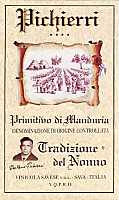
|
|
Primitivo di Manduria Tradizione del Nonno 2004 |
|
| Vinicola Savese (Apulia, Italy) | |
| Grapes: Primitivo | |
| Price: € 16.00 | Score: |
| This Primitivo di Manduria shows an intense ruby red color and nuances of garnet red, little transparency. The nose denotes intense, clean, pleasing and refined aromas that start with hints of plum, blackberry and black cherry followed by aromas of dried violet, vanilla, tamarind, tobacco, licorice, mace, carob and menthol. The mouth has good correspondence to the nose, a tannic attack and pleasing roundness, however balanced by alcohol, full body, intense flavors. The finish is persistent with flavors of plum, blackberry and black cherry. Part of this Primitivo ages in barrique. | |
| Food Match: Game, Roasted meat, Braised and stewed meat, Hard cheese | |
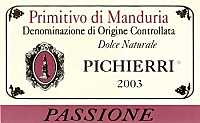
|
|
Primitivo di Manduria Dolce Naturale Passione 2003 |
|
| Vinicola Savese (Apulia, Italy) | |
| Grapes: Primitivo | |
| Price: € 23.00 - 500ml | Score: |
| The wine shows a deep ruby red color and nuances of garnet red, little transparency. The nose denotes intense, clean, pleasing and refined aromas that start with hints of blackberry jam, black cherry jam and prune followed by aromas of dried violet, vanilla, tobacco, tamarind, nail polish, chocolate and mace. The mouth has good correspondence to the nose, a sweet and tannic attack, however balanced by alcohol, full body, intense flavors. The finish is persistent with flavors of blackberry jam and prune. Primitivo di Manduria Passione ages for 8 months barrique and in earthenware containers. | |
| Food Match: Chocolate desserts, Hard cheese, Dried fruit tarts | |
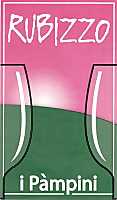
|
|
Rubizzo 2005 |
|
| I Pampini (Latium, Italy) | |
| Grapes: Merlot | |
| Price: € 5.50 | Score: |
| Rubizzo shows an intense ruby red color and nuances of purple red, little transparency. The nose reveals intense, clean and pleasing aromas that start with hints of black cherry, blueberry and black currant followed by aromas of plum, violet and carob. The mouth has good correspondence to the nose, a slightly tannic attack and however balanced by alcohol, good body, intense flavors. The finish is pretty persistent with flavors of black cherry and blueberry. Rubizzo ages for few months in cask. | |
| Food Match: Pasta and legumes, Sauteed meat | |
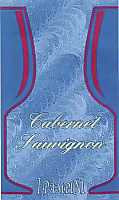
|
|
Cabernet Sauvignon 2005 |
|
| I Pampini (Latium, Italy) | |
| Grapes: Cabernet Sauvignon | |
| Price: € 8.40 | Score: |
| This wine shows an intense ruby red color and nuances of ruby red, little transparency. The nose denotes intense, clean and pleasing aromas which start with hints of black cherry and black currant followed by aromas of blueberry, plum, geranium and carob. The mouth has good correspondence to the nose, a tannic attack and however balanced by alcohol, good body, intense flavors. The finish is persistent with flavors of plum and black currant. Part of this Cabernet Sauvignon ages in cask. | |
| Food Match: Sauteed meat with mushrooms, Stuffed pasta, Broiled meat and barbecue | |
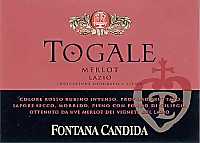
|
|
Togale 2005 |
|
| Fontana Candida (Latium, Italy) | |
| Grapes: Merlot | |
| Price: € 4.20 | Score: |
| Togale shows a brilliant ruby red color and nuances of ruby red, moderate transparency. The nose denotes intense, clean and pleasing aromas that start with hints of black cherry, blueberry and plum followed by aromas of violet, vanilla and carob. The mouth has good correspondence to the nose, a slightly tannic attack and however balanced by alcohol, good body, intense flavors. The finish is pretty persistent with flavors of black cherry and plum. A small part of Togale ages for 4 months in barrique. | |
| Food Match: Stuffed pasta, Sauteed meat, Roasted white meat | |
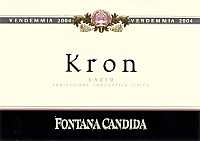
|
|
Kron 2004 |
|
| Fontana Candida (Latium, Italy) | |
| Grapes: Merlot (85%), Sangiovese (15%) | |
| Price: € 16.50 | Score: |
| Kron shows a brilliant ruby red color and nuances of garnet red, moderate transparency. The nose denotes intense, clean, pleasing and refined aromas that start with hints of plum and blueberry followed by aromas of black cherry, violet, vanilla, tobacco, cinnamon, carob and mace. The mouth has good correspondence to the nose, a tannic attack and however balanced by alcohol, good body, intense flavors, agreeable. The finish is persistent with flavors of plum, blueberry and black cherry. Kron ages for 12 months in barrique followed by 6 months of aging in bottle. | |
| Food Match: Broiled meat and barbecue, Roasted meat, Stewed meat | |
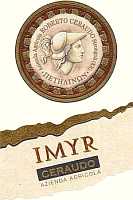
|
|
Imyr 2005 |
|
| Ceraudo (Calabria, Italy) | |
| Grapes: Chardonnay | |
| Price: € 13.00 | Score: |
| Imyr shows an intense golden yellow color and nuances of golden yellow, very transparent. The nose reveals intense, clean, pleasing and refined aromas which start with hints of banana, plum and toasted wood followed by aromas of citrus fruits, coffee, hawthorn, apple, grapefruit and hazelnut. The mouth has good correspondence to the nose, a crisp and smooth attack, however balanced by alcohol, good body, intense flavors. The finish is persistent with flavors of banana, apple and plum. Imyr ages for 6 months in barrique. | |
| Food Match: Roasted white meat, Stuffed pasta, Roasted fish | |
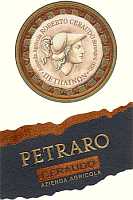
|
|
Petraro 2004 |
|
| Ceraudo (Calabria, Italy) | |
| Grapes: Cabernet Sauvignon | |
| Price: € 16.00 | Score: |
| Petraro shows an intense ruby red color and nuances of garnet red, little transparency. The nose reveals intense, clean, pleasing and refined aromas that start with hints of black cherry, black currant and plum followed by aromas of blueberry, dried violet, vanilla, tobacco, cocoa and eucalyptus. The mouth has good correspondence to the nose, a tannic attack and however balanced by alcohol, good body, intense flavors, agreeable. The finish is persistent with flavors of black cherry, plum and black currant. Petraro ages for 18 months in barrique. | |
| Food Match: Roasted meat, Braised and stewed meat, Hard cheese | |
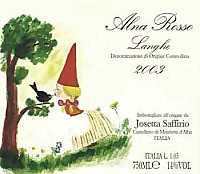
|
|
Langhe Rosso Alna 2005 |
|
| Josetta Saffirio (Piedmont, Italy) | |
| Grapes: Merlot (90%), Nebbiolo (10%) | |
| Price: € 15.00 | Score: |
| Langhe Rosso Alna shows an intense ruby red color and nuances of ruby red, little transparency. The nose reveals intense, clean, pleasing and refined aromas that start with hints of black cherry, plum and black currant followed by aromas of raspberry, blueberry, cyclamen and vanilla. The mouth has good correspondence to the nose, a tannic attack and however balanced by alcohol, good body, intense flavors. The finish is persistent with flavors of black cherry and plum. Langhe Rosso Alna ages for 12 months in cask. | |
| Food Match: Broiled meat and barbecue, Roasted meat, Stewed meat | |

|
|
Barolo 2003 |
|
| Josetta Saffirio (Piedmont, Italy) | |
| Grapes: Nebbiolo | |
| Price: € 28.00 | Score: |
| This Barolo shows a brilliant ruby red color and nuances of garnet red, moderate transparency. The nose denotes intense, clean, pleasing and refined aromas which start with hints of cherry, raspberry and plum followed by aromas of strawberry, violet, rose, vanilla, tobacco, licorice, chocolate, cinnamon and menthol. The mouth has good correspondence to the nose, a tannic attack and however balanced by alcohol, full body, intense flavors, agreeable. This Barolo ages for 24 months in cask and for 6 months in cement tanks followed by 6 months of aging in bottle. | |
| Food Match: Game, Braised and stewed meat, Roasted meat, Hard cheese | |
Tenuta ValdipiattaEstablished in 1973 by Giulio Caporali, the winery is today run by his daughter Miriam who, in few years, has achieved important and excellent results with her wines |
|
Those of Montepulciano are among the most ancient wines of Italy known today and which arrived up to nowadays. These wines are mentioned for the first time in 789, in a document of the churchman Arnipert with which he donates to the church of Saint Silvester in Lanciniano sull'Amiata - in the province of Siena - a vineyard of the Policiano castle. Mentions of Vino of Montepulciano are also found in other documents of later years, however its real consecration will arrive in 1549, when Sante Lancerio, wine adviser of Pope Paolo III, by mentioning this wine defined it as truly perfect wine, worth of gentlemen. The road to “nobility” begins in 1685, when Francesco Redi - doctor, naturalist and lettered from Arezzo - expressed his appreciation for this wine in his dithyramb Bacco in Toscana (Bacchus in Tuscany) by ending it with the verse “Montepulciano d'ogni vino è Re” (Montepulciano is the king of all wines). King, but not noble yet. The wine of Montepulciano will become for the first time noble in 1787, when in a bill of Giovan Filippo Neri - Governor of Royal Retreat of San Girolamo - the renowned wine was defined and described with the adjective “nobile”, that is, noble.
The nobility of Vino di Montepulciano is intact still today and certainly increased, through the excellent results obtained by many producers, among them, Tenuta Valdipiatta. Established in 1973, the new course of Tenuta Valdipiatta begins at the end of 1980s, when Giulio Caporali, animated by his passion for land and wine, decides to acquire an old farmhouse and some hectares of vineyards in the hills that from Montepulciano degrade towards Valdichiana. He then decides to completely dedicate himself to the restoration of the vineyards and cellar, convinced of the need of renewing and modernizing the estate. He then proceeds with the expanding of the cellar dug in the tuff of a hill, destined to the aging of wines, as well as building a new cellar destined to the procedures of production and wine making. Besides the historical vineyards of Bossona and Sanguineto - considered among the best “cru” for Vino Nobile - are also acquired two vineyards at Ciarliana and Banditella, in which were already cultivated Sangiovese and Canaiolo Nero varieties. Tenuta Valdipiatta also decides the cultivation of “international” varieties, by planting in these new vineyards Cabernet Sauvignon and Merlot, although keeping its primary interest for the production of Vino Nobile di Montepulciano. All the vineyards have been renewed in the first years of 1990s, with the exception of the two crus “Sanguineto” and “Vigna d'Alfiero”, both planted in the beginning of 1970s. From “Vigna d'Alfiero” will be created in 1999 the most prestigious Tenuta Valdipiatta's Vino Nobile di Montepulciano and which is named after Alfiero Carpini, the first cellar master of the estate, who in 1968 planted in this vineyard Sangiovese Grosso - known in Montepulciano as Prugnolo Gentile - and from which it is being produced the homonymous wine in limited quantities. The production of “Vigna d'Alfiero” follows very strict methods, including a low yield per hectare - lesser than 40 quintals - followed by a scrupulous selection of the best grapes. The wine is then allowed to age in cask for at least two years.
Since 2004, Tenuta Valdipiatta is run by Miriam Caporali - Giulio's daughter - who in her grace and kindness, reveals an entrepreneurial dynamic attitude as well as clear ideas about the future of the winery. From 1997 to 2002, Miriam Caporali works with her father in the management of the winery and of vineyards, then she obtains a master in enology at the University of Bordeaux. Miriam Caporali personally takes care of the management of the winery and the commercialization of her wines, whereas her father Giulio continues to take care of the vineyard. Since 2002, the management of wine production is in charge to Mauro Monicchi, the talented wine maker who studied at the school of Prof. Yves Glory - tenured in Enology in the University of Bordeaux and consultant of Tenuta Valdipiatta since 1998 - and, among the other things, has also some years of experience in many Châteaux of Bordeaux. Miriam Caporali is also supported by the collaboration of Urano Carpini - Alfiero's son - and Gabriella Alunni, respectively production manager and administrative manager. Tenuta Valdipiatta currently own about 40 hectares of lands, of which 30 destined to vineyards and 2 to olive trees, mainly located in the hills of Montepulciano at an altitude of 350 meters above sea level. The cultivation of vineyards is done according to the methods of organic agriculture and the only type of fertilizer used is of organic origin. In order to ensure the best result and quality, all the operations are done manually. The rooms destined to the vinification are equipped with the most modern machines for the processing of the must and wines, and the wine making technologies are the result of the continuous experimentation done at Tenuta Valdipiatta. Recently, Tenuta Valdipiatta has built, inside of its structure, a modern laboratory of analysis with which it is possible to ensure a constant control of wines during the entire production cycle. The most important restoration works done at Tenuta Valdipiatta have been realized from 2000 to 2002, period in which they also extended the headquarter and built a new room destined to the aging of bottles and to store the wines ready to be commercialized. The historical cellar dug in the tuff and near the headquarter of Tenuta Valdipiatta, accommodates inside the casks for the aging of wines. In fact, inside this cellar are found large Slovenian oak casks, that is the traditional type of cask used for the aging of Vino Nobile di Montepulciano, as well as about 300 barriques. Tenuta Valdipiatta's wines are distributed in Italy, Austria, Belgium, Brazil, South Korea, Denmark, France, Germany, Japan, England, Ireland, Luxembourg, Malaysia, Norway, Netherlands, Czech Republic, Russia, Sweden, Switzerland and United States of America. Among the most representative productions of Tenuta Valdipiatta are mentioned Vino Nobile di Montepulciano, in particular the “Riserva” style and “Vigna d'Alfiero”, as well as Trefonti - produced with Cabernet Sauvignon, Canaiolo Nero and Sangiovese grapes - and Trincerone, a blend of Canaiolo Nero and Merlot. To them was recently added the last ambitious Super Tuscan of Tenuta Valdipiatta: a 100% Pinot Noir aged for 12 months in French oak barriques.
|
||||||||||||||||||||
|
Score legend Prices are to be considered as indicative. Prices may vary according to the country or the shop where wines are bought |
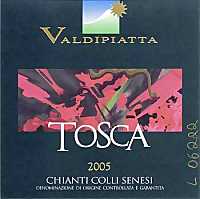
|
|
Chianti Colli Senesi Tosca 2005 |
|
| Tenuta Valdipiatta (Tuscany, Italy) | |
| Grapes: Sangiovese (90%), Canaiolo Nero (10%) | |
| Price: € 8.00 | Score: |
| Chianti Colli Senesi Tosca shows a brilliant ruby red color and nuances of ruby red, moderate transparency. The nose denotes intense, clean and pleasing aromas that start with hints of black cherry, plum and violet followed by aromas of blueberry and vanilla. The mouth has good correspondence to the nose, a tannic attack and however balanced by alcohol, good body, intense flavors. The finish is persistent with flavors of plum and black cherry. This wine ages for 6 months in cask followed by 6 months of aging in bottle. | |
| Food Match: Stuffed pasta, Broiled meat and barbecue, Stewed meat | |
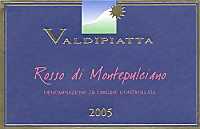
|
|
Rosso di Montepulciano 2005 |
|
| Tenuta Valdipiatta (Tuscany, Italy) | |
| Grapes: Sangiovese (80%), Canaiolo Nero (15%), Mammolo (5%) | |
| Price: € 9.50 | Score: |
| This Rosso di Montepulciano shows an intense ruby red color and nuances of ruby red, moderate transparency. The nose denotes intense, clean, pleasing and refined aromas that start with hints of plum and raspberry followed by aromas of black cherry, blueberry, strawberry, violet and vanilla. The mouth has good correspondence to the nose, a tannic attack and however balanced by alcohol, good body, intense flavors. The finish is persistent with flavors of plum and black cherry. Part of this Rosso di Montepulciano ages for 3 months in barrique. | |
| Food Match: Pasta with meat, Broiled meat and barbecue, Stewed meat | |
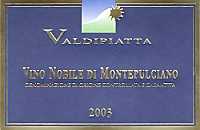
|
|
Vino Nobile di Montepulciano 2003 |
|
| Tenuta Valdipiatta (Tuscany, Italy) | |
| Grapes: Sangiovese (85%), Canaiolo Nero (15%) | |
| Price: € 17.00 | Score: |
| This Vino Nobile di Montepulciano shows a brilliant ruby red color and nuances of garnet red, moderate transparency. The nose denotes intense, clean, pleasing and refined aromas which start with hints of black cherry, plum and violet followed by aromas of blueberry, vanilla, tobacco, pink pepper, chocolate, mace and menthol. The mouth has good correspondence to the nose, a tannic attack and pleasing roundness, however balanced by alcohol, full body, intense flavors. The finish is persistent with flavors of black cherry, plum and blueberry. This Vino Nobile di Montepulciano ages for 12 months in cask followed by 6 months of aging in bottle. | |
| Food Match: Game, Roasted meat, Stewed and braised meat, Hard cheese | |
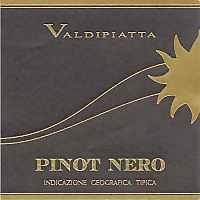
|
|
Pinot Nero 2004 |
|
| Tenuta Valdipiatta (Tuscany, Italy) | |
| Grapes: Pinot Noir | |
| Price: € 40.00 | Score: |
| This Pinot Noir shows an intense ruby red color and nuances of garnet red, moderate transparency. The nose reveals intense, clean, pleasing, refined and elegant aromas which start with hints of cherry, plum and raspberry followed by aromas of cyclamen, dog rose, vanilla, tobacco, pink pepper, peanut butter, cocoa and menthol. The mouth has good correspondence to the nose, a slightly tannic attack and pleasing crispness, however balanced by alcohol, good body, intense flavors. The finish is persistent with flavors of cherry, plum and raspberry. This Pinot Noir ages for 12 months in barrique followed by 6 months of aging in bottle. | |
| Food Match: Stuffed pasta, Roasted meat, Stewed meat | |
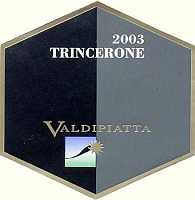
|
|
Trincerone 2003 |
|
| Tenuta Valdipiatta (Tuscany, Italy) | |
| Grapes: Canaiolo Nero (60%), Merlot (40%) | |
| Price: € 25.00 | Score: |
| Trincerone shows a brilliant ruby red color and nuances of garnet red, little transparency. The nose reveals intense, clean, pleasing, refined and elegant aromas that start with hints of black currant, black cherry and plum followed by aromas of violet, blueberry, licorice, vanilla, tobacco, chocolate, eucalyptus and mace. The mouth has good correspondence to the nose, a tannic attack and however balanced by alcohol, full body, intense flavors, agreeable roundness. The finish is persistent with flavors of black cherry, black currant and plum. A well made wine. Trincerone ages for 12 months in barrique followed by 12 months of aging in bottle. | |
| Food Match: Roasted meat, Braised and stewed meat, Hard cheese | |
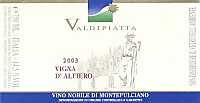
|
|
Vino Nobile di Montepulciano Vigna d'Alfiero 2003 |
|
| Grapes: Sangiovese | |
| Price: € 30.00 | Score: |
| Vino Nobile di Montepulciano Vigna d'Alfiero shows an intense ruby red color and nuances of garnet red, little transparency. The nose reveals intense, clean, pleasing, refined and elegant aromas that start with hints of black cherry, plum and blackberry followed by aromas of raspberry, violet, rose, blueberry, vanilla, tobacco, cinnamon, chocolate and mace. The mouth has good correspondence to the nose, a tannic attack and however balanced by alcohol, full body, intense flavors, pleasing roundness. The finish is persistent with flavors of black cherry, plum and blackberry. A well made wine. Vino Nobile di Montepulciano Vigna d'Alfiero ages for 18 months in barrique followed by 12 months of aging in bottle. | |
| Food Match: Game, Roasted meat, Stewed and braised meat, Hard cheese | |
| Tenuta Valdipiatta - Via della Ciarliana, 25A - 53040 Montepulciano, Siena (Italy) - Tel. +39 578 757930 Fax: +39 578 717037 - Winemaker: Mauro Monicchi - Established: 1973 - Production: 120.000 bottles - E-Mail: info@valdipiatta.it - WEB: www.valdipiatta.it |
News |
|
In this section are published news and information about events concerning the world of wine and food. Whoever is interested in publishing this kind of information can send us a mail to our address.
|
Making Wine: Topping Up and RackingsTwo fundamental techniques to obtain perfect wines, topping up and rackings are essential for wine's stability and to prevent many faults |
|
One of the main preoccupations of whoever makes wine is to prevent the development of faults which could compromise the quality of the finished product. To obtain this result, it is necessary to adopt specific measures and techniques in order to ensure the wine the best possible biological stability. At the end of fermentation, wine is not limpid and crystalline the way we are used to see it in our glasses after we pour it from the bottle. Making a wine limpid takes time, a process that - among the other things - is favored by many conditions which can also be obtained by means of the biological stability of wine. The operations of topping up and rackings are considered fundamental in order to obtain a good wine, stable, with no faults and fine: that's why it is usually said rackings are the fundamental secret to obtain perfect wines. At high quantities, oxygen is an enemy of wine, therefore it will be paid attention on avoiding its contact as much as possible, a condition which can be easily obtained by means of topping up.
Among the preoccupations of whoever makes wine, there is also how to keep it in the best possible condition, in order to avoid the development of faults and to ensure the best possible biological stability. The choice of the containers to be used for the keeping, their use, temperature and humidity, are among the main factors ensuring the best conditions of stability, from aging to bottling. Wine is a live product which comes to the world, grows up and, finally, dies. This “biological” cycle is widely influenced by many factors ensuring the longest and best possible life, of course, according to the type of wine. The lack of optimal conditions or neglecting the “health” of the wine, will cause not only a sick condition, but also its premature death. The operations of topping up and rackings, which we will discuss later, are fundamental procedures to obtain a good wine, however not enough in case are not adopted good conditions of keeping. In “industrial” wine making, or however in most of commercial wineries making wine, stability of wine is also obtained by means of other procedures, not always possible in home making, both because of their cost, as well as for practical reasons. Among the many, pasteurization and filtering which can be obtained by using specific tools and which ensure the best biological stability of wine by removing negative bacteria and suspended particles. Despite these two techniques are frequently used in the commercial production of wine, indeed their use is frequently debated and in some case they are avoided in order to keep the wine as much “genuine” as possible. In fact, pasteurization and filtering allow the elimination of some unwanted substances from the wine and which could be cause of faults or spoilage, however these operations also remove other substances that - as a matter of fact - impoverish the wine although ensuring a better biological stability. In home wine making we can certainly avoid both pasteurization and filtering, however it is essential the fundamental condition for the keeping and the health of the wine are ensured. As we said in previous articles, hygiene and cleanliness of the containers used in the many phases of wine making is essential. It will also be essential in the room used for the keeping are found the fundamental hygienic conditions in order to avoid the spoilage of containers used for keeping the wine - in particular wood containers - and which could compromise the stability of wine. For this reason, after the operations of racking - and in case it is necessary, after the operation of topping up - it is important to clean the room, in particular the floor, and all the tools used. Despite Louis Pasteur defined wine as “the most healthy and hygienic of beverages”, this does not mean such conditions spontaneously happen, moreover, it should be remember wine is swallowed: another good reason to pay attention on hygiene.
|
||||||||||||
|
Oxygen is a friend-enemy of wine, a role determined according to the quantity and surface in contact with it. In very reduced quantities, the action of oxygen is useful for the aging of wine, something which happens - for example - in the cask. In fact, oxygen passes through the pores of the wood and reaches the inside of the cask, therefore coming in contact with the wine. However the quantity received this way is very low, favoring - as a matter of fact - a micro oxygenation indispensable for the chemical and organoleptic development of wine. In excessive quantities, it causes the oxidation of wine's components, with negative and unpleasing effects according to an organoleptic point of view. Oxygen is also a “friend” during tasting as it allows, also favored by the swirling of the glass, the development and perception of wine's aromas. During production it is however considered an “enemy” and its contact with the wine will be avoided as much as possible. No matter the type of container used for the keeping of wine, it is fundamental the direct contact with oxygen is avoided as much as possible. For this reason, no matter the type of container - demijohn, cask, barrique, steel or cement tanks - it is essential they are always topped up and full: a condition which avoids the contact with oxygen. When the wine is poured in the keeping container, it will be important to fill it as much as possible, by leaving the least possible space between the cap and the level of the wine. During the keeping, changes of temperature and season will cause rises and lowering of the level, therefore changing the surface in contact with oxygen while increasing the risks of oxidation. Moreover, in case of cask, part of the wine passes through the pores of the wood, therefore diminishing the level inside of it and increasing, at the same time, the surface in contact with oxygen. For this reason, at least once every two weeks, we will check the level of the wine inside the keeping containers and we will do, according to needs, topping up by adding wine up to reaching a “safe” level. For the topping up will be used the same wine kept in a small container - for example, a small demijohn - which will be however kept in good conditions by avoiding the contact with the air, by covering its surface, for example, with a layer of vaseline oil. For the topping up of large containers, such as casks and tanks, it is convenient the use of specific topping up caps - available in shops specialized in wine making items and which can also be used as air-locks during fermentation - which allow an easy check of the level of wine and to see when a topping up is needed. Topping up cap is mounted in the cask's bung and therefore it is filled with wine, therefore it is sealed with its cap. When needed, new wine is added to the topping up cap, therefore keeping the cask full. For small containers, such as demijohns, they must be completely filled up to few centimeters below the opening, then it is poured some vaseline oil, therefore isolating the wine from the contact with the air.
|
|
It is said rackings are the secret for obtaining perfect wines and the experience teaches us this is true. In fact, by means of rackings it is possible to obtain very limpid wines, allowing the removal of unwanted solid and negative substances, therefore quality wines according to an organoleptic point of view. At the end of fermentation, the wine is turbid and with many suspended particles that, besides compromising the appearance, they can, with time, cause faults and spoilage. These solid substances in suspension - mainly made of yeast cells, residual of grape skins and pulp - will deposit on the bottom of the container, therefore, by means of rackings, we will separate the limpid part from the solid one. The precipitation of solid substances also happens after some weeks from every racking, a phenomenon therefore requiring the repetition of this procedure. With every racking is obtained a more stable and limpid wine, refined and perfect, therefore - according to the type of wine and its consumption - this operation will be done periodically during aging and before bottling. Rackings can be considered a natural clarification method, a process with which - by means of sedimentation of solid substances - it is possible to obtain a limpid and clear wine. As already mentioned, these solid substances are made of yeast cells, residuals of grape's skin, pulp and pips, more or less soluble salts, such as potassium bitartrate, and - in case of red wines - coloring substances and polyphenols. These substances will deposit on the bottom of the container and will make the so called lees that, in contact with the limpid wine, can be cause of spoilage and faults. In fact, lees contain micro organisms which could cause faults in wine, moreover, they can be the place for chemical reactions, in particular in the condition of “reduction”, that is in absence of oxygen. In this specific case could develop unpleasing aromas and tastes, such as sulphydric acid, a smell recalling “rotten eggs”, or mercaptan, recalling the smell of garlic. The presence of lees can also be cause of haziness in case they are moved and suspended in the wine. For all these reasons, lees must be removed from the wine by means of rackings. In wine making, there are two types of rackings, used according to the conditions of the wine and its health. Open racking, or racking in contact with air, and close racking, or racking with no contact of the air. Open racking is done by transferring the limpid part of the wine in an open container which is then immediately transferred to the destination container. This procedure allows the wine to oxygenate and it is useful in case there are unpleasing smells - in particular at the end of fermentation - which can be removed by this procedure. Close racking is done by avoiding any contact of the wine with the air, by connecting the two containers with a pipe and with which will be transferred the limpid wine to the destination container. According to the type of container, the racking can be done by using a wine pump with which the wine will be transferred from one container to another, or, in case of small containers, it can be used a siphon. It is essential the part of the pipe with which the wine is drawn off is far above the sedimented lees, as - besides making the wine turbid - it must not be transferred to the destination container, of course. The first racking is usually done in contact with the air, in order to favor the elimination of any possible unpleasing smell, whereas all the other rackings are usually done with no contact of the air. The racking with no contact of the air must be however done when the test of the air - described in previous articles - gives a negative result, that is in case the wine is not very resistant to the air and which can easily oxidize or spoil. After every racking, the volume of the wine diminishes - because of the removal of the lees - therefore at the end of this operation, the destination container will be topped up. The quantity of rackings and their periodicity vary according to the type of wine and the aging cycle. During the first year are usually done three or four rackings. The first racking is done after two or three weeks from the racking following the end of fermentation, in order to separate the wine from gross lees. In case a wine was made with spoiled grapes or having evident signs of mold or rot, it is best to do the first racking in advance, in order to remove bacteria and pathogen micro organisms. The second racking is generally done at the beginning of winter, after the arrive of the cold which will favor the precipitation of solid substances and potassium bitartrate. The third racking is done at the beginning of spring, in the period from March to April. At this point, white wines not destined to aging can be bottled, whereas for red wines and white wines destined for aging, will be done - when necessary - a fourth racking before the arrival of summer, generally in the period from June to July. When necessary, it will be done a fifth racking with the arrive of autumn. In the following years, according to the type of wine, will generally be done two rackings per year. It should be remembered that during the aging of wine and rackings, the quantity of free sulfur dioxide diminishes, therefore it is recommended to replace the lost part by adding 2 or 3 grams of sulfur dioxide for every one hundred liters of wine (4 or 6 grams of potassium metabisulfite for every one hundred liters). Finally, it is good to remember the containers receiving the wine must be clean and washed with a sulphurated solution, as described in previous articles. A final consideration about weather conditions: rackings are always done with clear sky and dry weather, when the pressure is high. Otherwise, gases dissolved in wine will tend to get free, causing the suspension of the lees and therefore making the wine less limpid.
|
SaffronProduced from the stigmas of Crocus Sativus, saffron is a very ancient spice, capable of giving its characteristic aroma to dishes and its brilliant golden yellow color |
|
The plant from which is obtained saffron, name derived from the Persian za'faran or zaa-fran meaning “yellow”, is Crocus Sativus, belonging to the family of iridaceae, genus Crocus. The adult plant is made of a bulb of about 5 centimeters, containing about twenty gems, of which only three will give origin to leaves and flowers, whereas the remaining ones will produce secondary bulbs. During development of the plant, two or three sprouts come out from the soil containing leaves and flowers. At the center of the flower are found three red stigmas and from which are obtained the famous spice known as “saffron”.
Crocus Sativus derives from the artificial selection of a plant coming from Crete island and, because it is an intensive and artificial selection, that is made by man, the plant is sterile, therefore the only way of reproduction is by cloning it, by separating secondary bulbs from primary bulbs. The saffron plant likes climates with moderate rains, an altitude from 500 to 700 meters above sea level, it does not like rainy climates and soils retaining water. It likes permeable and well drained soils. As for temperature, the plant is very tolerant: in summertime it can stand to high temperatures and in wintertime it can stand to light frosts and temperature down to -10° C. The bulb of the saffron plant is very sensitive to the action of parasite fungi. Some animals, such as boar and porcupine, are very greedy of the bulbs of Crocus Sativus, therefore they are potentially dangerous for non fenced plantations. Also mice are to be considered dangerous for stored bulbs waiting to be planted. Saffron is among the richest spices in carotenoids and contains about 150 volatile aromatic substances.
|
||||||||
|
The plant comes from the Middle East or from the East, from the areas of Iran, India and Kashmir. The saffron plant, that is Crocus Sativus, was introduced in Italy by a Dominican monk around 1300, the culture soon spread all over the country and then faced a period of decline, whereas today it seems to have a renewed interest. Saffron is known since immemorial times: it was mentioned by Homer in the Iliad, whereas Pliny the Elder knew its therapeutic properties as a remedy for stomach ulcers, as well as a remedy for cough and angina pectoris. Egyptians used it for dyeing fabrics, to make perfumes and unguents and, last but not the least, to flavor foods. The School of Salerno praised its cheering and comforting properties. In the Bible was mentioned in the “Song of Solomon” book, in the fourth chapter, associated to the most aromatic and precious essences. In the Middle Age it was used as a remedy against epilepsy, it was used as a remedy against plague, and it was known for its cheering effects. In commercial exchanges of the Republic of Venice, saffron was very important and was opened a specific office, exclusively reserved for the trading of this spice. From the thirteenth century on, commercial exchanges increased and, at the same time, the middle class began to learn, besides the pleasures of the body, also the pleasure of the table. Ortensio Lando, an Augustinian monk, mentioned saffron in one of his writings, and he asserted during the period of Lent the risk of putting on weight was very high, because the fish cooked with the aromatic herbs were very delicious. In the monastery of “Santa Colomba” in Perugia was found an old cookbook, dated back to the 1500s, in which are mentioned many recipes based on saffron. Many believe during the Middle Age spices were used to cover the taste of meat that was not well kept. This is probably false, as whoever could afford buying spices could also easily buy fresh meat, also every day. Adding spices to food was a way to show off richness and power. This hypothesis is also confirmed by a writing of “Ménagier”, a rich executive who lived in Paris during the fourteenth century, and wrote an “instruction manual” for the house dedicated to his young wife: «…dishes, whenever possible, must be colored: the chicken must be boned, stuffed with meat, eggs and cheese, it must be boiled and then grilled in a spite, brushed with egg yolks and saffron…Babylonians used to burn incense, myrrh and saffron during processions. According to Assyrian customs, Semiramide cultivated saffron in the hanging gardens of Babylonia, one of the seven wonders of the world. Cleopatra used it as a cosmetic and to dye her skin, nails, lips and hair. In ancient Jerusalem is was greatly demanded for liturgies. Saffron was not used only for cooking and it was frequently used for the production of cosmetics. In 2000 BC in Crete Island saffron was used to color the breast and lips of women. During the Greek civilization the aesthetical aspect of a person was exalted and the care for the body and dressing became very important. Among the ingredients used for perfumes and colorants, saffron was one of the most important ones, and it became the main ingredient of the two most exclusive perfumes of Athens: Susinum and Crocinum. Greek mythology tells about a handsome man named Crocus who fell in love with the beautiful nymph Smilace, the favorite one of the god Hermes. The god, in order to punish Crocus, transformed him into a flower of saffron. Also according to Greek mythology, the bed of Zeus, king of the Olympus, was spread of saffron flowers. Romans, despite imperial laws forbade it, imported perfumes and essences from Greece and from other countries. The use of these perfumes became common among rich people and they became a status symbol. In the tables of the most rich people, wine was frequently mixed to saffron. In Roman thermae, rich people used to take a bath in water mixed essences and saffron. The cultivation of saffron, called for many centuries “vegetal gold”, began in Europe, and at the end of 1300s it was very common in Italy, Spain and Greece. In Italy it is mainly cultivated in Abruzzo, in the upland of Navelli, in Sardinia in the production areas of saffron DOP, in Umbria at Cascia and in Tuscany in the province of Siena. In these areas the production of saffron is still active and, in some of them, the quality is very high. In Europe, saffron was certainly introduced by Arabs around the tenth century, however some believe it was introduced by Phoenicians, skilled merchants of this precious spice.
|
||||
|
Saffron has many qualities, such as stimulating metabolism, helping digestion, contrasting aging, reducing the level of cholesterol and lowering blood pressure. The high content in carotenoids gives saffron antioxidant qualities as well as the property of increasing immunitary defenses. Saffron is frequently used by people on a weight loss diet, as it can flavor foods while keeping the calories low. Chinese medicine recognizes to saffron detoxifying, depurative and anti inflammatory properties. Indian medicine suggests the daily consumption of saffron in order to help digestion and to contrast bowel's inflammations. In past times saffron was known for its sedative and anti spastic properties. The excessive use of saffron can cause vertigo, torpor, hemorrhages and the reduction of the number of platelets. Saffron is currently used by food industry and in cooking as a spice and as a colorant. In cooking saffron gives its best with dishes made of rice, seafood and white meats, it is also used to exalt the taste of dishes made of light flavored vegetables. The active principles are represented by crocine, picocrocine and safranel. Crocine is responsible for the color of saffron, whereas safranel is responsible for the aroma. Crocine is a yellow colored substance soluble in water: in case it is kept in a moist environment, the absorption of water causes its decaying therefore producing crocetine, insoluble and with a reddish color; for this reason, when it comes in contact with water, saffron rekindles its colors. The harvesting of saffron is pretty laborious: flowers must be harvested by hand, in the morning, when flowers are still closed, and by expert and delicate hands in order not to damage stigmas. The stigmas are manually separated from the flower and then they are toasted or dried. To obtain one kilogram of finished product are required about 150,000 flowers. The phases of harvesting and toasting - or drying - are very delicate because the organoleptic quality of saffron largely depends on these operations. For this reason a quality product is very expensive. Powdered saffron usually found in many supermarkets is sometimes made of a small part of pure saffron, while the rest, most of the times, is made of less aromatic spices, such as turmeric. This explains the low price as well as its light taste.
|
AquavitaeReview of Grappa, Distillates and Brandy |
|
|
| Distillates are rated according to DiWineTaste's evaluation method. Please see score legend in the "Wines of the Month" section. |

|
|
Grappa di Moscato |
|
| Distilleria Zanin (Veneto, Italy) | |
| Raw matter: Pomace of Muscat Blanc | |
| Price: € 10.00 - 70cl | Score: |
| This grappa of Muscat is colorless, limpid and crystalline. The nose reveals intense, clean, pleasing and refined aromas of grape, peach, apple, pear, orange, candied fruit and white rose with almost imperceptible alcohol pungency. In the mouth is intense with perceptible alcohol pungency which tends to dissolve rapidly, good correspondence to the nose, balanced sweetness, agreeable. The finish is persistent with flavors of grape, peach and banana. This grappa is distilled with a discontinuous alembic still. Alcohol 40%. | |
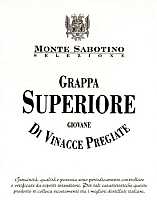
|
|
Grappa Superiore Giovane Monte Sabotino |
|
| Distilleria Zanin (Veneto, Italy) | |
| Raw matter: Pomace of grapes from Veneto | |
| Price: € 20.00 - 70cl | Score: |
| This grappa is colorless, limpid and crystalline. The nose reveals intense, clean, pleasing and refined aromas of plum, pear, hazelnut, licorice, raspberry and apple with almost imperceptible alcohol pungency. In the mouth is intense with perceptible alcohol pungency which tends to dissolve rapidly, good correspondence to the nose, balanced sweetness, pleasing roundness. The finish is persistent with flavors of plum, apple and hazelnut. This grappa is distilled with a discontinuous alembic still. Alcohol 40%. | |
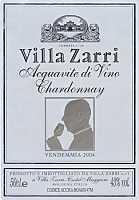
|
|
Acquavite di Vino Chardonnay 2004 |
|
| Villa Zarri (Emilia Romagna, Italy) | |
| Raw matter: Wine from Chardonnay grape | |
| Price: € 22.00 - 50cl | Score: |
| This wine brandy is colorless, limpid and crystalline. The nose denotes intense, clean, pleasing and refined aromas of pear, banana, apple, and plum with almost imperceptible alcohol pungency. In the mouth is intense with perceptible alcohol pungency which tends to dissolve rapidly, good correspondence to the nose,balanced sweetness, agreeable. The finish is persistent with flavors of apple and banana. This wine brandy is distilled in discontinuous “Charentais” alembic still and ages for at least 10 months in steel containers. Alcohol 43%. | |
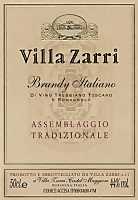
|
|
Brandy Italiano Assemblaggio Tradizionale 10 Anni |
|
| Villa Zarri (Emilia Romagna, Italy) | |
| Raw matter: Wines from Trebbiano Toscano and Trebbiano Romagnolo grapes | |
| Price: € 35.00 - 50cl | Score: |
| This brandy shows an intense amber yellow color, limpid and crystalline. The nose reveals intense, clean, pleasing, refined and elegant aromas of prune, dried fig, tobacco, coffee, vanilla, licorice, chocolate, honey, lavender, hazelnut and ripe banana with almost imperceptible alcohol pungency. In the mouth is intense with perceptible alcohol pungency which tends to dissolve rapidly, pleasing smoothness, balanced sweetness, very agreeable. The finish is very persistent with long flavors of licorice, hazelnut, ripe banana, honey and prune. A well made brandy. This wine brandy is distilled in discontinuous “Charentais” alembic still and it is made of a blend of 10 different wine brandies aged in barrels, of which the youngest is 10 years old. Alcohol 44%. | |
Wine Parade |
|
|
| The best 15 wines according to DiWineTaste's readers. To express your best three wines send us an E-mail or fill in the form available at our WEB site. |
| Rank | Wine, Producer | |
|---|---|---|
| 1 |
| Don Antonio 2003, Morgante (Italy) |
| 2 |
| Sagrantino di Montefalco Collepiano 2003, Arnaldo Caprai (Italy) |
| 3 |
| Nero al Tondo 2001, Ruffino (Italy) |
| 4 |
| Amarone della Valpolicella Classico Costasera 2001, Masi (Italy) |
| 5 |
| Soave Classico Monte Alto 2004, Ca' Rugate (Italy) |
| 6 |
| Chianti Classico Riserva Novecento 2000, Dievole (Italy) |
| 7 |
| Sforzato di Valtellina Canua 2001, Conti Sertoli Salis (Italy) |
| 8 |
| Wine Obsession 2001, Vignamaggio (Italy) |
| 9 |
| Barolo Cannubi Boschis 2001, Sandrone (Italy) |
| 10 |
| Amarone della Valpolicella Classico 2000, Zenato (Italy) |
| 11 |
| Barolo Bussia 2001, Prunotto (Italy) |
| 12 |
| Mater Matuta 2003, Casale del Giglio (Italy) |
| 13 |
| Brunello di Montalcino 1999, Castello Banfi (Italy) |
| 14 |
| Collio Bianco Col Disôre 2004, Russiz Superiore (Italy) |
| 15 |
| Sagrantino di Montefalco 2003, Antonelli (Italy) |
| |||||||
Privacy Policy | |||||||


| Copyright © 2002-2024 Antonello Biancalana, DiWineTaste - All rights reserved |
| All rights reserved under international copyright conventions. No part of this publication and of this WEB site may be
reproduced or utilized in any form or by any means, electronic or mechanical, without permission in writing from DiWineTaste. |